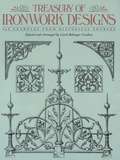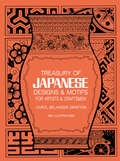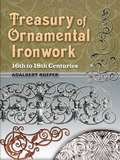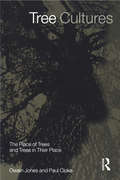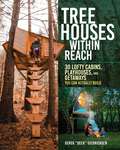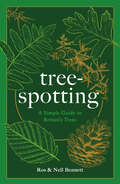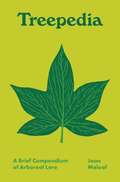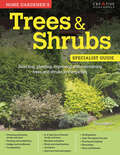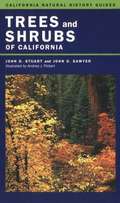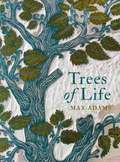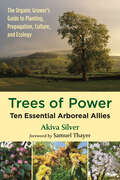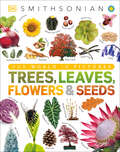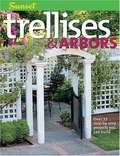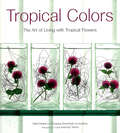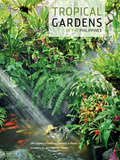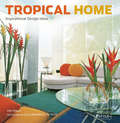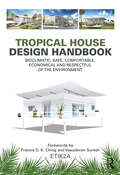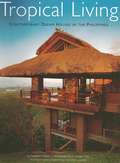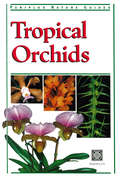- Table View
- List View
Treasury of Ironwork Designs: 469 Examples from Historical Sources (Dover Pictorial Archive)
by Carol Belanger GraftonThe history of Western decorative arts is filled with splendid examples of ornamental ironwork — elaborately wrought designs for gates and fences, finials and posts, banisters, window grilles, signs and marquees, cathedral screens, and a host of other architectural and decorative features. This practical archive brings together nearly 500 outstanding examples of the ironmaker's art. Meticulously rendered in fine black-and-white line art, the designs have been reprinted from rare European and American catalogs and periodicals of the nineteenth and early twentieth centuries, including L'Art Pour Tous, Art Journal, The Illustrated London News, Harper's Monthly, and others.The designs illustrated here date from the Middle Ages through the nineteenth century, encompassing the ornate figuration of the Renaissance, the exuberant innovations of Baroque and Rococo artists, and the sinuous designs of nineteenth-century ironworkers inspired by the Art Nouveau aesthetic. Artists, architects, designers, and craftspersons will find this volume an ideal sourcebook of beautiful designs — all royalty-free — from a great tradition in the decorative arts.
Treasury of Japanese Designs and Motifs for Artists and Craftsmen (Dover Pictorial Archive)
by Carol Belanger GraftonA profound sense of the aesthetic beauty in all things pervades the whole of Japanese culture, finding perhaps its clearest expression in the decorative, applied, and pictorial arts. Characterized by a mastery of line and composition, and noted for lyrical scenes of exquisite beauty, the genius of Japanese art has bequeathed to the world a remarkable and distinctive design legacy. This exceptionally versatile collection of traditional Japanese designs and motifs presents the working artist with a treasury of 360 copyright-free designs. All have been especially adapted by noted artist Carol Belanger Grafton for ready use by illustrators, designers, and craftspeople. Painstaking effort has been made to preserve the original spirit and subtlety of detail while simultaneously sharpening the lines and enhancing the reproducibility of the designs and motifs. There are several lovely ceramic and textile patterns. However, most of the design motifs in this compendium were taken from woodblock prints. This particular medium was invented in China and introduced to Japan before 1000 A.D., flourishing thereafter and reaching its zenith in the Ukiyo-e ("floating world") school of the 17th, 18th, and 19th centuries. Accompanying these depictions of people in traditional garb, and accessories such as fans, keys, kites, and umbrellas, are many charmingly decorative family crests arranged in mostly circular configurations. Also included are full-page compositions of bold geometric design, vignettes of ethereal delicacy, as well as a generous sampling of nature's bounty: cherries, radishes, plum blossoms, lions, elephants, dogs, cranes, parrots, turtles, butterflies, even demons and dragons, and much more―often in several arrangements, many with reversed images.Artists, designers, illustrators, students, and teachers will find this indispensable collection of 360 traditional Japanese designs and motifs rendered in clean, crisp, black-and-white, copyright-free illustrations to be a remarkably fertile source of illustrative inspiration and design solutions.
Treasury of Ornamental Ironwork: 16th to 18th Centuries
by Adalbert RoeperSixty vintage black-and-white plates illustrate the history of German decorative ironwork from the16th to the 18th centuries. A hard-to-find celebration of the diversity and enduring beauty of Germany's handcrafted iron embellishments, this magnificent edition exhibits striking views of metal doors, balconies, window arches, gates, corner pieces, decorative accessories, and more, many wrought with gargoyles, human figures, and florals. A rich source of inspiration and an accurate, invaluable reference for art historians, architects, craftworkers, and designers.
Tree Cultures: The Place of Trees and Trees in Their Place
by Paul Cloke Owain JonesThe relationship between nature and culture has become a popular focus in social science, but there have been few grounded accounts of trees. Providing shelter, fuel, food and tools, trees have played a vital role in human life from the earliest times, but their role in symbolic expression has been largely overlooked. For example, trees are often used to express nationalistic feelings. Germans drew heavily on tree and forest imagery in nation-building, and the idea of 'hearts of oak' has been central to concepts of English identity. Classic scenes of ghoulish trees coming to life and forests closing in on unsuspecting passers-by commonly feature in the media. In other instances, trees are used to represent paradisical landscapes and symbolize the ideologies of conservation and concern for nature. Offering new theoretical ideas, this book looks at trees as agents that co-constitute places and cultures in relationship with human agency. What happens when trees connect with human labour, technology, retail and consumption systems? What are the ethical dimensions of these connections? The authors discuss how trees can affect and even define notions of place, and the ways that particular places are recognized culturally. Working trees, companion trees, wild trees and collected or conserved trees are considered in relation to the dynamic politics of conservation and development that affect the values given to trees in the contemporary world. Building on the growing field of landscape study, this book offers rich insights into the symbolic and practical roles of trees. It will be vital reading for anyone interested in the anthropology of landscape, forestry, conservation and development, and for those concerned with the social science of nature.
Tree Houses within Reach: 30 Lofty Cabins, Playhouses, and Getaways You Can Actually Build
by Derek DiedricksenThis lively showcase of wildly different and eclectic tree houses will inspire anyone who has ever dreamed of building a tree house of their own. The tree houses featured in Tree Houses within Reach range from simple platform structures to raised office spaces, tiny houses to playhouses—proving that a tree house can be creative, useful, and beautiful while still being affordable and accessible to those with modest building skills. With extraordinary photos and fascinating profiles of the stories behind the builds, author Derek Diedricksen has curated this collection of tree houses with his trademark eye for quirkiness, thrift, and reused materials—featuring everything from a robot-themed tree house with salvaged windows to a 38-square-foot pod that relies solely on trees for support. For those eager to start their own projects, Diedricksen leads the reader through the most important nuts & bolts of tree house building and offers tips and suggestions throughout. The book includes step-by-step photographs of a basic sample build.
Tree-spotting: A Simple Guide to Britain's Trees
by Nell Bennett Ros BennettA beautifully illustrated guide to the marvellous and varied world of trees, and a fascinating introduction to the hidden secrets of 52 British species. Botanist and ecologist Ros Bennett has spent a lifetime helping people understand and identify plants and always hoped her daughter Nell would grow up to share her love of the natural world.During Nell's childhood years they spent much time exploring the local woods together. Here, Nell discovered the visual and tactile beauty of trees.In Tree-spotting, Ros and Nell have combined their backgrounds and talents to show you – through Ros's extensive experience and Nell's exquisite illustrations – how to identify 52 British trees simply and confidently.A beautiful and captivating insight into the wonderful world of trees, Tree-spotting burrows down into the history and hidden secrets of each species. It explores how our relationship with trees can be very personal, and will bring you closer to the natural world around you.
Tree-spotting: A Simple Guide to Britain's Trees
by Nell Bennett Ros BennettA beautifully illustrated guide to the marvellous and varied world of trees, and a fascinating introduction to the hidden secrets of 52 British species. Botanist and ecologist Ros Bennett has spent a lifetime helping people understand and identify plants and always hoped her daughter Nell would grow up to share her love of the natural world.During Nell's childhood years they spent much time exploring the local woods together. Here, Nell discovered the visual and tactile beauty of trees.In Tree-spotting, Ros and Nell have combined their backgrounds and talents to show you – through Ros's extensive experience and Nell's exquisite illustrations – how to identify 52 British trees simply and confidently.A beautiful and captivating insight into the wonderful world of trees, Tree-spotting burrows down into the history and hidden secrets of each species. It explores how our relationship with trees can be very personal, and will bring you closer to the natural world around you.
Treepedia: A Brief Compendium of Arboreal Lore (Pedia Books)
by Joan MaloofA captivating A–Z treasury for the tree hugger in all of usTreepedia is an entertaining and fact-filled illustrated compendium of tree lore. Featuring nearly 100 entries—on topics ranging from tree ecology and conservation to the role of trees in religion, literature, art, and movies—this enticing collection is a celebration of all things arboreal.In this charming book, Joan Maloof explains the difference between a cedar and a cypress, and reveals where to find the most remarkable trees on the planet. She tells the story behind the venerable Bodhi Tree, and describes peculiar species like baobabs and Fitzroya. Maloof profiles legendary conservationists such as Julia "Butterfly" Hill, John Muir, Wangari Maathai, and Ken Wu. She discusses reforestation, proforestation, emerald ash borers, the ents from The Lord of the Rings, culturally modified trees, the ill-fated and controversial Redwood Summer, and much more. The book's portable size makes it the perfect travel companion no matter where your love of the forest may lead you.With enchanting illustrations by Maren Westfall, Treepedia is a fun and informative book that is guaranteed to inspire anyone who has ever enjoyed a walk in the woods.Features a real cloth cover with an elaborate foil-stamped designUses 100 percent recycled, uncoated, wood-free paper
Trees & Shrubs: Selecting, planting, improving and maintaining trees and shrubs in the garden (Home Gardener's)
by David SquireImprove your outdoor space with this detailed guide to selecting, planting, pruning, and renovating every kind of tree and shrub. No matter what the type of garden or outdoor space, trees and shrubs are usually featured. This is because they are so versatile. Depending on the species chosen, shrubs and trees can form the background to a garden, be a focal point or add height to an overlooked garden. Whatever your garden needs, a tree or shrub can provide it. Home Gardener&’s Trees & Shrubs details the basics of choosing, buying, planting, establishing, and transplanting. A comprehensive plant directory has A–Z lists of species within different categories: seasons, color, size etc. The final section of the book looks at how to care for shrubs and trees, giving practical advice on how to prune and clip, and the pests, diseases, and other problems to watch out for.
Trees and Shrubs of California
by John D. Stuart John O. SawyerA compact field guide to all the trees and the most common shrubs of California.
Trees of Life
by Max AdamsAn informative, richly illustrated book about eighty of the world’s most important and remarkable treesOur planet is home to some three trillion trees—roughly four hundred for every person on Earth. In Trees of Life, Max Adams selects, from sixty thousand extant species, eighty remarkable trees through which to celebrate the richness of humanity’s relationship with trees, woods, and forests.In a sequence of informative and beautifully illustrated portraits, divided between six thematic sections, Adams investigates the trees that human cultures have found most useful across the world and ages: trees that yield timber and other materials of immense practical value, trees that bear edible fruits and nuts, trees that deliver special culinary ingredients and traditions, and trees that give us dyes, essences, and medicines. In a section titled “Supertrees,” Adams considers trees that have played a pivotal role in maintaining natural and social communities, while a final section, “Trees for the Planet,” looks at a group of trees so valuable to humanity that they must be protected at all costs from loss.From the apple to the oak, the logwood to the breadfruit, and the paper mulberry to the Dahurian larch, these are trees that offer not merely shelter, timber, and fuel but also drugs, foods, and fibers. Trees of Life presents a plethora of fascinating stories about them.
Trees of Power: Ten Essential Arboreal Allies
by Akiva SilverThe organic grower&’s guide to planting, propagation, culture, and ecologyTrees are our allies in healing the world. Partnering with trees allows us to build soil, enhance biodiversity, increase wildlife populations, grow food and medicine, and pull carbon out of the atmosphere, sequestering it in the soil.Trees of Power explains how we can work with these arboreal allies, specifically focusing on propagation, planting, and individual species. Author Akiva Silver is an enthusiastic tree grower with years of experience running his own commercial nursery. In this book he clearly explains the most important concepts necessary for success with perennial woody plants. It&’s broken down into two parts: the first covering concepts and horticultural skills and the second with in-depth information on individual species. You&’ll learn different ways to propagate trees: by seed, grafting, layering, or with cuttings. These time-honored techniques make it easy for anyone to increase their stock of trees, simply and inexpensively.Ten chapters focus on the specific ecology, culture, and uses of different trees, ones that are common to North America and in other temperate parts of the world:Chestnut: The Bread TreeApples: The Magnetic CenterPoplar: The HomemakerAsh: Maker of WoodMulberry: The Giving TreeElderberry: The CaretakerHickory: Pillars of LifeHazelnut: The ProviderBlack Locust: The Restoration TreeBeech: The Root RunnerTrees of Power fills an urgent need for up-to-date information on some of our most important tree species, those that have multiple benefits for humans, animals, and nature. It also provides inspiration for new generations of tree stewards and caretakers who will not only benefit themselves, but leave a lasting legacy for future generations.Trees of Power is for everyone who wants to connect with trees. It is for the survivalist, the gardener, the homesteader, the forager, the permaculturist, the environmentalist, the parent, the schoolteacher, the farmer, and anyone who feels a deep kinship with these magnificent beings.
Trees, Leaves, Flowers and Seeds: A Visual Encyclopedia of the Plant Kingdom (DK Our World in Pictures)
by DKPacked with more than 1,000 incredible images and full of fascinating facts, this beautiful children&’s book takes you on an exciting expedition through the wonders of the plant kingdom.Have you ever wondered which plants eat insects? Or how cacti store water? How about which flowers look like bees? Or where is the tallest tree in the world? If you find yourself seeking the answers to these quirky questions and so many more, then Trees, Leaves, Flowers & Seeds may be the book for you! Explore the incredible world of plants, from the smallest seeds to the tallest trees, whilst you discover all about the weirdest, smelliest and deadliest flowers on our planet, with this engaging encyclopedia for children aged 9-12. Celebrate your child's curiosity as they explore:- Striking and detailed diagrams, drawings, and illustrations on every page - A highly visual approach to learning - An ideal combination of colorful diagrams with infographic text boxes- In association with The Smithsonian InstitutionThis captivating kids encyclopedia also takes a fun, more sideways look at some truly strange plants, such as trees with fruits like a giant&’s fingers, orchids that look like monkey faces, seeds that spin like helicopters, and trees that drip poison! The striking illustrations, photographs and diagrams featured throughout provide an optimum visual learning experience for both children and adults alike, accompanied by an array of fun facts all about your favorite flowers, plants, trees and more.This plant encyclopedia includes at-a-glance panels that provide a quick reference to all the stats, making this nature book an ideal combination of colorful diagrams and infographic text boxes. In association with DK Smithsonian, the text proves easily accessible for readers aged 9-12, yet can be enjoyed by the entire family, making this enthralling children&’s encyclopedia a beautiful and educational gift that can be passed down generations.Learn all about the world one picture at a time!If you like Trees, Leaves, Flowers & Seeds, then why not complete the collection? Part of the highly visual Our World In Pictures series, avid readers can dive into the world of dinosaurs with The Dinosaur Book, become a vehicle virtuoso with Cars, Trains, Ships and Planes and venture on a journey across the globe with Countries, Cultures, People & Places.
Trellises And Arbors
by Sunset Publishing Staff Steve CoryThere are so many reasons readers will get attached to this new edition of Sunset's best-selling "Trellises & Arbors". For starters, it's all new, and expanded with 32 pages and over 250 brand-new photographs, many of which show how other homeowners have used obelisks, arbor benches, eye-catching latticework, and vegetable supports to provide privacy, form outdoor rooms, frame garden paths, and give climbing vines and roses a place to thrive. Then there are the projects themselves--more than 40 in all, ranging from a simple fan trellis to a dramatic tunnel arbor, giving builders of all skill levels a range of ways to create stunning garden focal points. Best of all, these projects use standard-dimension lumber and don't require special woodworking skills. Features: expanded edition with 32 additional pages, over 250 new how-to photographs, over 40 projects for beginning to advanced woodworkers, classic trellis and arbor designs that enhance any setting, and a new techniques chapter with information on safety, cutting methods, setting posts, and pouring concrete.
Trends in Urban Design: Insights for the Future Urban Professional (Contemporary Urban Design Thinking)
by Rob RoggemaUrban planning practice will undergo significant changes in the upcoming decades, due to major changes and challenges the world has to deal with, such as loss of biodiversity loss, climate change impacts, agricultural transformation, water management issues and health. The way the urban professional has to relate to this new order is explored in this book by collecting a series of conversational chapters with local, regional, national and international experts in the fields of urban planning and design, urban and building development, building and construction industry, architecture, governments and academia. The unification of a desirable future with real world processes such as economic and decision-making practice is key. Moreover, the attitude of the future urban professional will more and more shift from an expert in a specific field to a communicative advisor in complex processes.
Tropical Colors
by Luca Invernizzi Tettoni Sakul Intakul Wongvipa Devahastin Na Ayudhya[In this stunning book, renowned Thai floral artist Sakul Intakul combines colorful tropical flowers, exotic foliage and other unusual design materials in refreshingly original floral displays suitable for any occasion and any setting. Photographed in the spectacular, contemporary homes of Thailand's leading artists, designers and professionals, the simple but imaginative floral displays evoke the essence of a modern Asian style.]This refreshingly original book goes beyond the everyday-elevating tropical flowers from mere floral arrangements to meditative floral "art installations" that serve as dramatic design centerpieces in contemporary tropical homes. Created from a combination of exotic and colorful tropical flowers, plant materials-fibers and leaves from the banana and coconut, twigs from the bamboo-and other less orthodox materials like wire netting, the arrangements harmoniously blend a strong, usually three-dimensional structure with the sweet and subtle elements of flowers. Allow Tropical Colors to inspire you, adding a gorgeous Asian flair to your home!
Tropical Gardens of the Philippines
by Elizabeth Reyes Luca Invernizzi Tettoni Lily Gamboa O'BoyleOffering a rare glimpse into some of the most beautiful tropical gardens in the world, Tropical Gardens of the Philippines presents spectacular contemporary gardens--large and small--situated in and around the Metropolitan Manila area and the nearby provinces of Laguna, Batangas and Tagaytay. This gorgeous volume introduces a contemporary gardening style that has been evolving in the Philippines over the past decade as talented designers have come into their own--not to mention all the talented homeowners who are making this happen. All are finding their own original niches in attempting to define a unique tropical gardening style.
Tropical Home: Inspirational Design Ideas
by Luca Invernizzi Tettoni Kim InglisThis Asian interior design and architecture book showcases the best luxury homes and interior spaces of the Pacific region.Asia has emerged in the last couple of decades as the global leader in tropical villa design. <P><P>With innovative indoor/outdoor architecture engineered to facilitate relaxed, al fresco lifestyles, there are myriad solutions to suit every taste and pocket. Featuring hundreds of homes, garden estates, hotels, restaurants and more from India to Indochina, Indonesia to Sri Lanka, the design book gives a tantalizing glimpse of the latest trends for tropical wannabe decorators.Full-color photography of interiors and exteriors, garden features, pools and pavilions, as well as decorative details and fashion forward furniture, is accompanied by insightful text that traces past history and present trends, and predicts what is to come, design wise, in the future.
Tropical Hotels: Thailand Malaysia Singapore Java Bali
by Jacob Termansen Kim Inglis Pia Marie MolbechTropical Hotels showcases the best boutique hotels and resorts in Bali, Java, Singapore, Malaysia and Thailand. Southeast Asia is renowned the world over for its superb standards of resort architecture, hotel service and interior design. With over 300 ravishingly beautiful, full-color photographs, this book doubles up as a guidebook to fabulous places to stay and a treasure trove of interior design and architecture.
Tropical Hotels: Thailand Malaysia Singapore Java Bali
by Jacob Termansen Kim Inglis Pia Marie MolbechTropical Hotels showcases the best boutique hotels and resorts in Bali, Java, Singapore, Malaysia and Thailand. Southeast Asia is renowned the world over for its superb standards of resort architecture, hotel service and interior design. With over 300 ravishingly beautiful, full-color photographs, this book doubles up as a guidebook to fabulous places to stay and a treasure trove of interior design and architecture.
Tropical House Design Handbook: Bioclimatic, Safe, Comfortable, Economical and Respectful of the Environment
by Etik2aPacked with accessible information, this book covers all the technical and practical aspects of home design in tropical environments. . It begins by outlining the prerequisites needed to understand the issues involved (climate, heat, thermal comfort, etc.) and discusses the solutions offered by traditional housing. It then identifies current solutions for protecting buildings and their occupants from solar radiation and external heat, while promoting bioclimatic and environmentally friendly approaches. . The economic viability of the solutions identified is discussed, as are the advantages and disadvantages of the materials, depending on the context and standards in force. . Numerous examples illustrate how buildings can be adapted to local realities, from the avant-garde creations of Jean Prouvé to those of today’s architects who are committed to sustainable development, as well as specific projects incorporating the recommendations made in this book. More than 460 photos, drawings, diagrams, tables, maps, house plans, logos and pictograms illustrate this reference work for all those involved in construction in tropical regions, particularly students in the field and, more generally, anyone – from professionals to private individuals – looking for useful information on this subject.
Tropical Interiors
by Elizabeth Reyes A. Chester OngFeaturing over 250 photographs and insightful commentary, this topical interior design book will add a uniquely Asian-Pacific element to your home.<P><P>The Philippines is home to a new generation of craftsmen, including furniture makers, artists, sculptors, and weavers. They specialize in taking the indigenous materials of the country--pina, abaca, capiz shell, bamboo, rattan, to name a few--and producing contemporary items that would be as at home in a New York loft as on a tropical verandah. Harnessing both Asian- and Latin-inspired style and modern techniques, they produce a cornucopia of fine contemporary furniture and "authentic" furnishing items.In this sourcebook of decorating and shopping ideas, these objects are presented within metropolitan and rural present-day interiors. From furniture and furnishings to table settings and lighting, all the homes, many never photographed before, are accented with artifacts in modern designs.Tropical Interiors shows how Philippine style is clearly now a global phenomenon and can be applied to homes worldwide.
Tropical Living
by Elizabeth Reyes A. Chester OngStart with a warm tropical climate. Add an abundance of exotic natural building material. And then let the cross currents of Asian design and aesthetics create a rich architectural alchemy of it's own. The result? The exquisite homes of the Philippines, a perfect balance of form and functionality, beautifully portrayed in Tropical Living.
Tropical Living
by Elizabeth Reyes A. Chester OngStart with a warm tropical climate. Add an abundance of exotic natural building material. And then let the cross currents of Asian design and aesthetics create a rich architectural alchemy of it's own. The result? The exquisite homes of the Philippines, a perfect balance of form and functionality, beautifully portrayed in Tropical Living.
Tropical Orchids
by David P. BanksTropical Orchids is the latest title in Periplus' series of Nature Guides, which cover diverse subjects of tropical flora and fauna. This volume is a handy field guide that provides an excellent introduction to over 120 exotic orchid species found in Southeast Asia, many unique to the region. Included are full-color photographs of their extraordinarily beautiful blooms and a wealth of expert botanical information. The photographs by David P. Banks, noted authority on tropical orchids, will delight orchid lovers all over the world.
